 Like many board game enthusiasts, I often used Ticket to Ride (TtR) to open the eyes of non-gamers to a world where you can play a board game and not rely on dice to tell you where to go (a.k.a. roll and move, a.k.a boring, a.k.a. Monopoly).
Like many board game enthusiasts, I often used Ticket to Ride (TtR) to open the eyes of non-gamers to a world where you can play a board game and not rely on dice to tell you where to go (a.k.a. roll and move, a.k.a boring, a.k.a. Monopoly).
To be honest, because my collection of games has exploded in recent years, I would only break out TtR when gaming with friends or relatives who did not play many board games. I like TtR, but I have moved on to games I find more enjoyable.
When I heard about Ticket to Ride: Rails & Sails (TtR: R&S) at Gen Con 2016, I was intrigued. It was billed as a more strategic version of TtR. I looked forward to trying the game and was lucky enough to be given the opportunity to review it. More importantly, is TtR: R&S a heavier game than TtR, or is it simply TtR with boats?
Game Overview:
TtR: R&S is a card drafting and set collection game in which you build train and boat routes by matching the color of the cards you have drafted to the color of the routes on the board. It supports two to four players and clocks in at about 30 minutes per player. Ticket to Ride players, that is NOT a typo….
Game Components:
The components for Ticket to Ride: Rails & Sails were good.
I liked:
-
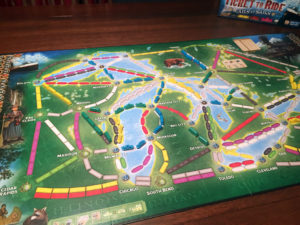
The board is dual sided, with a world map on one side and the great lakes region on the other. The board – It is big (bigger than the standard TtR board), colorful, and, except for one caveat (see below), easy to read and follow. It is double-sided with a map of the world on one side and a map of the Great Lakes region of the United States on the other. Both maps play slightly differently, adding to the replay value of the game. For the color blind, the board utilizes different symbols on the routes for specific colors. Finally, the route shapes for boats (oval) are shaped differently than for trains (rectangle).
- The plastic train, boat and harbor pieces – They are detailed and easy to differentiate by type. And there are A LOT of them (340 to be exact).
- The card quality – The cards were not flimsy and were easy to shuffle. The art on the cards was well done as well, except for one issue (see below). The cards also use the same symbols present on the board to assist the color blind.
I did not like:
- The edges of the board on the World map – Some routes end on the edge of the board and wrap around to the other side. This would in itself not be a problem; however, some of these routes have spaces that need to be counted on BOTH sides, whereas others did not. This inconsistency led to confusion in our games and several times when players thought they had enough cards to complete a route, they realized they had missed one or more spaces on the other side of the board. NOTE: This issue does not exist on the Great Lakes map, as no routes wrap around.
- Differentiating between train and boat cards – This is not as easy as you would think. Yes, the art on the cards clearly depict a boat or a train; however, the layout of both types of cards are very similar. There are some differences, but they are not obvious when you have many cards in your hand and are looking to find five red cards. I may sound like I am exaggerating, but every player at one time in our games tried to use boat cards for train cards or vice versa.
How to Play:
Below is a high level summary of the game; however, feel free download a PDF of the official rules here.
On a player’s turn, they can do one of four actions:
-

There are new two decks of travel cards, train and boat. Take travel cards – There are six face up cards made up of a combination of boat and/or train cards. Train and boat cards come in six colors, but the train cards also have a seventh “color” – wild cards that can be used in place of either a boat or a train. The player will draft two cards from either the face-up cards or from the top of one of the draw decks.
- Claim a route – The board consists of many colored boat and train routes. A player can claim a route by turning in the cards that match the type of route (boat or train), color and number of spaces for that route. The appropriate plastic pieces are then placed on the route and the player earns points based on the length of the route.
- Draw tickets – These tickets have cities on them – the player’s goal is to connect these cities with a continuous chain of train and/or boat routes that the player claims during the game. These tickets are important to complete as they score bonus points at the end of the game and any uncompleted tickets will penalize the player with negative points. Additional ticket cards can be drawn for a turn.
Note: New to Ticket to Ride: Rails & Sails are Tour Tickets, special tickets that show multiple cities that score extra points if they are connected exactly as depicted on the card.
- Build a harbor – Some of the travel cards taken during the game will have a blue anchor symbol on them. A harbor can be built if a player a.) has a claimed route that leads into a harbor space, and b.) turns in four cards of the same color that all have the blue anchor symbol. Of these four cards, two cards must be boats and two must be trains. Harbors score points at the end of the game based on the number of COMPLETE TICKETS that have port city names that match the city in which the harbor was built.
Players start the game with three harbors. Any unconstructed harbors will cost the player four points.
- Exchange pieces – If a player runs out of boat or train pieces, they may choose to exchange them, and then lose two points.
The game end condition triggers when one player has six or fewer boat and/or train pieces left in their supply. When this happens, every player, including that player, has TWO more turns until the game ends.
The winner is the player with the most points after end of game scoring (completed and uncompleted tickets, as well as harbors and unbuilt harbors).
Note: TtR: R & S does not have a longest route or a most completed tickets bonus.
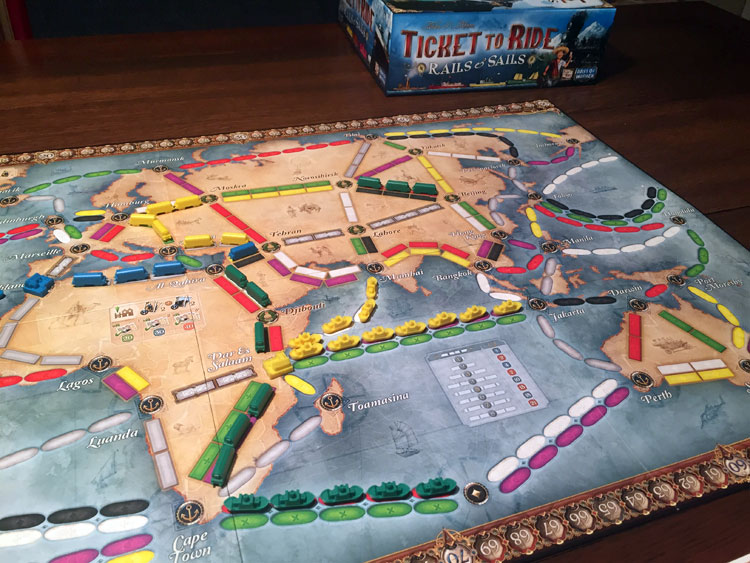
Game Experience:
I was really looking forward to playing Ticket to Ride: Rails & Sails; unfortunately, I did not enjoy this game as much as I thought I would.
I would NOT recommend using TtR: R&S as an introduction to our hobby. For newer gamers, I would recommend the original Ticket to Ride or Ticket to Ride: Europe (review here) instead.
In my opinion, Ticket to Ride: Rails & Sails fell short in two major areas – luck and game length.
The new boat deck is the biggest culprit for the increased luck factor. When a card is drafted from the six available face-up cards, it can be replaced with either a boat or a train card. This means that all six face up cards can be trains, three could be trains, three could be boats, one could be a train and the other five boats, etc.
If you need a specific card and no wild cards are face up (these are only in the train deck), you will be forced to either draft a card you do not need to replace it with the type you are looking for or you will have to draw blind. While drawing blind happens in Ticket to Ride, it does not occur nearly as often as it does in TtR: R&S because, in TtR, there were five face up cards that were ALL trains. Needless to say, the drawing of cards in TtR: R&S is even more random and luck driven than any other Ticket to Ride game.
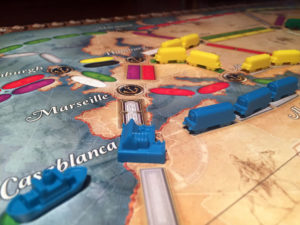
If you did not enjoy the luck factor of drawing and completing tickets in Ticket to Ride, the luck factor is even stronger in this game. The player who draws tickets that are near each other definitely has an advantage in TtR. This can be compounded by players who draw tickets as an action and are lucky enough to get one or two that they have already completed, as opposed to drawing cards that do not align with your current route structure. That’s a nice way of saying you just got hosed (remember that uncompleted routes are negative points during end of game scoring).
Harbors are scored based on the number of completed tickets matching where the harbor is constructed, with points increasing based on the number of these tickets going into the same city. This only compounds the luck factor associated with ticket drawing.
The other significant downside to the game is the game length. It took four experienced Ticket to Ride players slightly over two hours to finish our games even after multiple plays. This is due to the increased number of pieces used in the game (60 vs. 45), managing two types of cards and the amount of blind drawing that we experienced.
While the blind drawing has already been detailed and the increase in the number of pieces is self-explanatory, what surprised me most about the increase in game length was the impact of managing your hand. It may not sound like much, but trying to organize your hand led to some players having two piles in front of them, one for boats and one for trains. Flipping between these and trying to maximize your route building just slowed the game down.
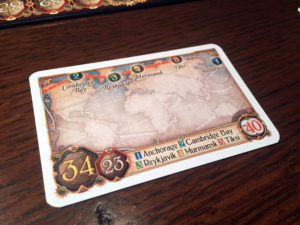
Some may consider it insignificant, but the increased time length really impacted our enjoyment of the game. In fact, in one of our games, as we approached the two-hour mark, one of the players began claiming the longest routes so that the end game would trigger; unfortunately, even the end game was lengthened for each player from one round to two rounds.
I know I am focusing on the negative, but I wanted to detail why I did not like the game as much as I hoped I would. That being said, if you like Ticket to Ride, and would not mind a longer game with more luck, you may enjoy Ticket to Ride: Rails & Sails. It has the same gameplay decisions that make TtR enjoyable: trying to decide when to claim a route vs. drafting cards, trying to complete tickets while trying to guess and potentially foil where your opponents are trying to complete their tickets. In addition, it will not be difficult for TtR veterans to understand and play this version.
Finally, the Great Lakes map improves on some of the issues I discussed above. It only uses 50 combined trains and boats versus 60 on the World Map. This helps reduce the game length. The Great Lakes map also eliminates the frustration of the wrap around routes. Finally, the value of Harbors is less than on the World map.
In case it is not obvious, of the two maps, I definitely preferred playing on the Great Lakes map!
Final thoughts:
I was not impressed with Ticket to Ride: Rails & Sails. I appreciate the attempt at changing up the Ticket to Ride formula, but the increased luck factor combined with the increased game length reduced my enjoyment of the game. I would only recommend Ticket to Ride: Rails & Sails to diehard Ticket to Ride fans who would not mind playing a longer version of Ticket to Ride that adds boats and a new set of cards to draw from.
If you’d like to get a copy of Ticket to Ride: Rails & Sails, you can pick it up for about $75.
Final Score: 2.5 Stars Overall – See Below.
World map: 2.5 Stars – A new formula for Ticket to Ride that falls flat due to the increased game length and increased luck factor.
Great Lakes map: 3.0 Stars – While the luck factor is only barely mitigated (harbors are worth fewer points), the shorter play time and lack of wrap around routes made this map the better game experience.
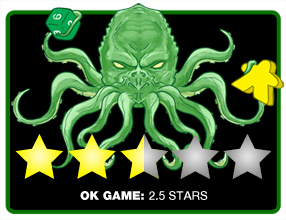 Hits:
Hits:
• Double sided board provides two maps that play slightly differently and adds replay value to the game
• The new Tour Tickets are a good twist on the usual Tickets used in TtR games
• The component quality is good
• The CONCEPT of using both rail and boat routes is a great idea…
Misses:
• The execution of the boat routes and the design of the decks did not work for me
• The game length is too long for what it is (it lasts about twice as long as a standard TtR game)
• The luck factor has increased through the inclusion of harbors and the second deck of cards (boats) to draw from







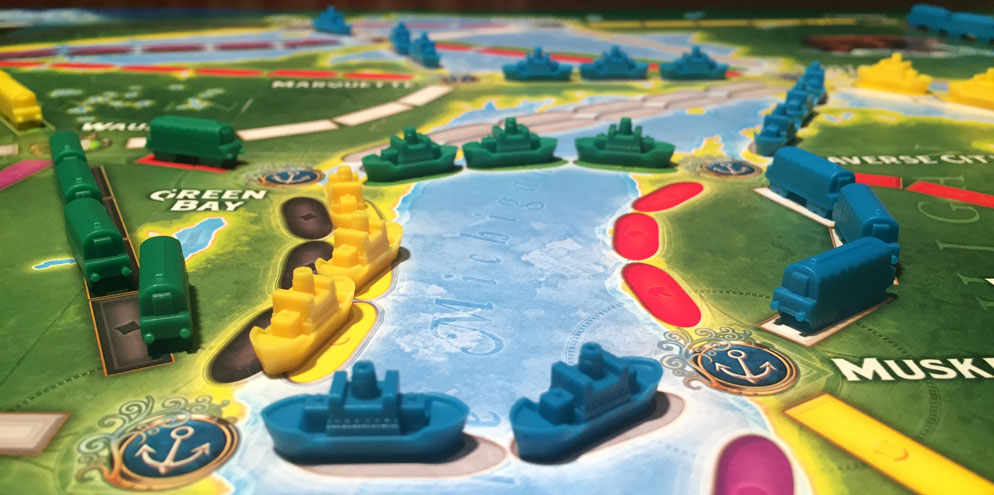















Two comments:
– you don’t lose 2 points when exchanging pieces but rather 1 per piece exchanged
– how come you have more than 3 of either travel card? We play with two separate decks, so there’s always 3 train cards and 3 boat cards. That might dial down the ‘drawing luck’ factor down a bit.
Other than that, R&S might be my favorite expansion, there’s times we play the game 7/8 times per week. You’re right though, about the card design. It’s really similar and often I mistake train cards for boat cards and vice versa. And something we sometimes encounter is that, whenever you need 7+ cards for a boat route, people start drawing boat cards and they end up with half the deck in their hand (especially the first time when we didn’t notice some boats were doubles)
Our average play time for 2/3 players is 1,5 hours so not too much I think.
Im planning to get this version of ttr, i like complexity on games, i first taught on getting the UK expansion who lookes great, but i had a litlle problem with that expansion, and that was it is only for a maximum of four playes, in my game table is at minimum 5 players always, so that detail made me not to buy UK version, and then i put my eyes on this one, what in my opinion is the second best of the series just below UK, and this one is for 5 players, yess!!
what is the tie breaker when all points are counted up? Just played and had that happen we had to make up our own determiner of the winner!
This is the best board game I have ever played!
This is hands-down my favorite board game. We (family of four) play every Sunday and I look forward to it all week. My only negative is that it is way too cumbersome to keep track of points after each turn (around the edge of the board): we add it all up at the end of the game while we remove the trains and ships for each player. R&S forever!